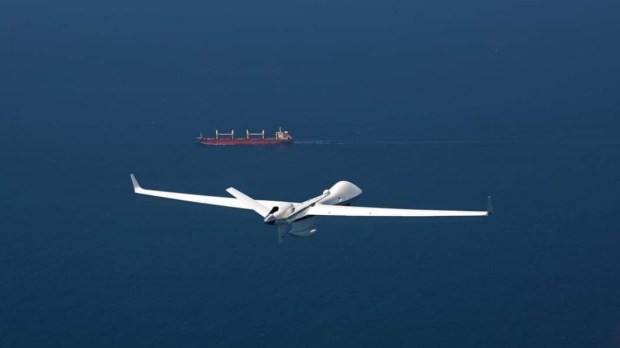By Group Captain Praveer Purohit (retd)
The waters surrounding India have witnessed increasing competition, conflict and chaos in the last few months. The maritime space encompassing the Indian Ocean Region (IOR) has seen a resurgence of piracy by Somali pirates who have used the opportunity provided by the crisis in the Red Sea to ‘make hay while the sun shines.’ Although not part of the US-led ‘Operation Prosperity Garden’, the Indian Navy has been thwarting attacks on maritime shipping from the Houthi rebels as well as pirates. The anti-piracy operation last month that involved the captured Malta-flagged Bulgarian-managed ship, MV Ruen, was unique in many ways.
The MV Ruen was captured by Somali pirates in December 2023 and forced into Somali territorial waters. In the second week of March, MV Ruen, now firmly under the control of Somali pirates, left Somali waters ostensibly to engage in more piracy. INS Kolkata, a guided missile destroyer operating in the area, sprang into action and intercepted the vessel on 15 March. A ship-launched drone confirmed that MV Ruen was under the control of pirates. The situation was complex because the 35 pirates had taken the 17-member crew of MV Ruen as hostage and were using them as a human shield.

Besides refusing to comply with the instructions from INS Kolkata, the pirates also shot down the drone and fired at INS Kolkata. Using established maritime procedures in accordance with the law, INS Kolkata responded by firing and crippling the steering system and navigation aids of Ruen. Unknown and unseen to the pirates were India’s air power assets, comprising the P-8I and Sea Guardian Remotely Piloted Aircraft (RPA) that had been continuously tracking and monitoring every move of the Ruen.
The venerable Chetak helicopter on board INS Kolkata was also in the thick of action. 16 March dawned with the pirates still refusing to surrender. Another warship, INS Subhadra, joined the operation that morning. Meanwhile, far away from the scene of action, a motley group of Indian Air Force (IAF) aircrew and Indian Navy (IN) special forces commandos (called MARCOS) were getting ready for an unusual mission in utmost secrecy. In a classic example of joint operations by the IAF and IN, an IAF C-17 aircraft flew 2600 kilometres to carry out a precise airdrop of Combat Rubberised Raiding Craft (CRRC) boats and the MARCOS. If the resolve of INS Kolkata had shaken the pirates, the paradrop of MARCOS through the ‘air vector’ was a bolt from the blue and the last straw. The pirates surrendered, and the captured crew were rescued, thus ending the IAF-IN joint operation successfully.
In executing an operation 2600 km from the mainland, India demonstrated its commitment to upholding international law, freedom of navigation and a rules-based order. India’s naval and air power projection for a global good, exemplified dependability. It also reassured littorals in the IOR and other rules-abiding countries that India was a trusted and reliable security partner. The Bulgarian President and US Defence Secretary conveyed their appreciation. While the nation is basked in the glory earned by the IN and IAF, a few important lessons need to be highlighted.
The Indian capability to undertake such faraway special operations did not develop overnight. It is an outcome of thoughtful and visionary decisions taken over a decade ago. The Cabinet Committee on Security (CCS) approved purchasing six C-130J aircraft in 2008 and another six in 2013. Since its induction in 2011, the C-130J has proved its mettle in challenging missions, both within and outside India. The purchase of P-8I aircraft was approved in 2009, and inductions commenced in 2012. Approval was given for purchasing ten C-17 aircraft in 2011, which were inducted from 2013 onwards. All these fleets have been extremely busy since their induction, earning laurels for the nation through their operational outcomes and humanitarian assistance. These versatile platforms’ capabilities have expanded the operating envelope and our options in the ‘grey zone’ of warfare. The increasing participation of IN and IAF in bilateral and multinational exercises with foreign forces has created more effective avenues for cooperation and interoperability, especially in Out Of Area Contingencies (OOAC).
The IAF has been at the forefront, conducting joint training with the Army and Navy’s special forces to exploit the capabilities of the C-17 and C-130J fully. This joint training has paid dividends. It should put to rest all misgivings, misconceptions and myths that regularly surface about the IAF’s alleged opposition to jointness. The absence of the highly hyped and debatable theatre commands neither impeded the joint training nor compromised the efficacy and conduct of this operation. The theatre command ‘bhakts’ have a lot of soul-searching to do.
India’s naval and air power provides the nation with far more effective choices to deal with challenges, contingencies and complexities in a chaotic world. Building naval and air power takes time and training and is heavily technology-dependent. It also requires a vision and commitment of adequate funds. The shortfall in the fighter aircraft of the IAF and the submarine fleet of IN, if not made up urgently, will haunt us in the future. The absence of a conflict is not a guarantee of peace. Only a strong, viable and potent deterrence capability is. The flawless execution of the Ruen operation is a testimony to the professionalism of our Navy and Air Force. It has also proven that the returns on investing in naval and air power are exceptionally good for the nation.
The author is a former Indian Air Force officer who has also served with the Indian Navy. He tweets @aparagonpilot
Disclaimer: Views expressed are personal and do not reflect the official position or policy of Financial Express Online. Reproducing this content without permission is prohibited.


